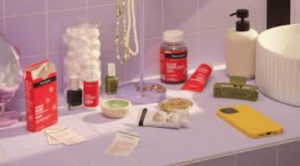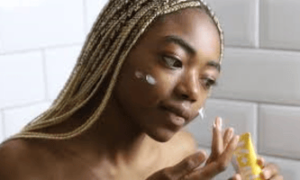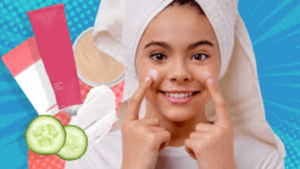Navigating the world of skincare for teenagers can feel overwhelming. One day your skin is perfectly fine, and the next, you’re dealing with breakouts, oiliness, or dryness that seems to come out of nowhere.
If you’re a teen struggling with skin concerns, you’re not alone. The hormonal changes that occur during adolescence dramatically affect your skin, making this the perfect time to establish good skincare habits that will benefit you for life.
I’ve created this comprehensive guide to help you understand what’s happening with your skin and how to care for it properly without falling for marketing gimmicks or harmful trends. We’ll also debunk common myths and provide science-backed advice that actually works for teenage skin.
This article will explore everything from understanding your skin type to building a simple but effective routine and also help you make informed decisions about your skincare journey.

Understanding Teenage Skin
The teenage years bring significant changes to your skin, primarily due to hormonal fluctuations. During puberty, your body increases production of androgens (a type of hormone), which stimulates sebaceous glands to produce more oil or sebum.
This natural process explains why many teenagers experience:
Increased oiliness – Especially in the T-zone (forehead, nose, and chin)
Acne breakouts – Including blackheads, whiteheads, and sometimes painful cystic acne
Larger pores – The larger pores are prone to clogging with dead skin cells and oil.
Increased sensitivity – Making skin more reactive to products and environmental factors
While these changes are completely normal, they don’t mean you’re destined to have problematic skin throughout your teen years. Understanding the unique needs of teenage skin is the first step toward developing an effective skincare routine.
Identifying Your Skin Type
Before purchasing any products, it’s important to determine your skin type. Even among teenagers, skin types vary widely:
Oily Skin
- Shiny appearance, especially by midday
- Prone to blackheads and breakouts
- Enlarged, visible pores
- Skin rarely feels tight or dry
Dry Skin
- Feels tight after washing
- May have flaky patches
- Smaller, less visible pores
- Rarely breaks out but can be sensitive
Combination Skin
- Oily in the T-zone but dry on cheeks and other areas
- Some enlarged pores in oily areas
- May experience breakouts in oily areas while having dryness elsewhere
Sensitive Skin
- Reacts easily to products with redness or irritation
- May sting or burn with certain ingredients
- Prone to rashes and bumps
- Requires extra gentle care
Acne-Prone Skin
- Frequent breakouts ranging from small whiteheads to larger cystic pimples
- Skin may be oily or combination
- More reactive to comedogenic ingredients
- May have post-inflammatory hyperpigmentation from previous breakouts
- Requires consistent care to prevent new breakouts
Many teenagers have combination skin and acne-prone skin type but your specific type might change seasonally or as you progress through adolescence. An effective skincare should be adaptable to these changes rather than rigidly following one approach.

Essential Skincare Steps for Teens
The foundation of good skincare routine doesn’t need to be complicated. Start with these essential steps:
Cleansing
Cleansing is perhaps the most important step in any teenage skincare routine:
- Select a mild cleanser that gets rid of extra oil without depleting the natural moisture in your skin.
- Ensure your face is washed twice daily, in the morning and the evening.
- Use lukewarm water because hot water can cause skin irritation and dryness.
- Be gentle – harsh scrubbing can irritate acne and spread bacteria
- If you have acne, look for cleansers that contain salicylic acid.
- Avoid harsh soaps that can disrupt your skin’s pH balance
Moisturizing
Moisturizing is essential, even if your skin is oily. Skipping this step can actually make oiliness worse as your skin might produce more oil to compensate for dryness.
- Select non-comedogenic, oil-free products that won’t clog pores.
- Apply moisturizer while skin is still slightly damp for better absorption
- Consider gel-based moisturizers for oily skin
- Seek out ingredients that hydrate without being heavy, such as hyaluronic acid.
- Apply moisturizer every time after cleansing
Sun Protection
This step is often overlooked in skincare for teenagers, but sun protection is essential for preventing premature aging and reducing hyperpigmentation from acne scars.
- Apply a broad-spectrum sunscreen every morning, make sure it has at least SPF 30
- Use sunscreen every morning even on days that are not so sunny
- Reapply every two hours when outdoors
- Look for oil-free, non-comedogenic formulations
- Consider physical sunscreens with zinc oxide or titanium dioxide if you have sensitive skin
Dealing With Common Teenage Skin Concerns
Acne Management
Acne is the most common skin concern for teenagers, affecting approximately 85% of young people between ages 12-24. Effective skincare for teenagers with acne includes:
- Using products with acne-fighting ingredients like benzoyl peroxide, salicylic acid, or adapalene
- Stop popping or plucking pimples, as this can cause scarring
- Being consistent with your routine
- Changing pillowcases frequently
- Keeping hair products away from your face
Oily Skin Solutions
Excessive oiliness can be frustrating, but with the right approach, it can be managed effectively:
- Use oil-absorbing sheets for midday shine
- Try clay masks once or twice weekly
- Consider using a lightweight toner with witch hazel
- Avoid heavy, occlusive products
- Look for the term ‘mattifying’ in products
Dry Patches & Sensitivity
Some teenagers experience dry skin, particularly in winter months:
- Use a more emollient moisturizer on dry areas
- Think of using a moisturizing serum that contains hyaluronic acid.
- Avoid hot showers which can strip natural oils
- Go for products that say ‘for sensitive skin’
- Before using new items all over your face, patch test them.
Building Your Teen Skincare Routine
A good skincare for teens routine should be simple enough to maintain consistently. Here’s a basic framework:
Morning Routine
- Cleanse with a gentle face was
- Apply a lightweight, oil-free moisturizer
- Finish with sunscreen (or use a moisturizer with SPF)
 Evening Routine
Evening Routine
- Cleanse to remove dirt, oil, and any makeup
- Apply treatment products if needed (like spot treatments for acne)
- Moisturize with a slightly richer formula for overnight hydration
Weekly Additions
- One or two times a week, use a mild exfoliator to get rid of dead skin cells
- Apply a clay mask in oily areas or a hydrating mask in dry areas
- Deep cleanse with a gentle face brush if recommended by a dermatologist
Skincare Ingredients Beneficial for Teen Skin
When selecting products for skincare for teenagers, look for these beneficial ingredients:
For Acne-Prone Skin
- Salicylic acid – clears clogged pores and lowers inflammation
- Benzoyl peroxide – kills acne-causing bacteria
- Niacinamide – reduces inflammation and helps regulate oil production
- Tea tree oil – natural antibacterial (use in small amounts)
For Hydration
- Ceramides support the functions of the skin barrier
- Glycerin draws moisture into the skin
- Hyaluronic acid draws and retains moisture.
- Aloe vera – soothes and hydrates
For Sensitive Skin
- Centella asiatica – calms inflammation
- Allantoin – soothes irritation
- Oat extract – provides gentle relief for sensitive skin
- Zinc – helps calm redness

Lifestyle Factors Affecting Teen Skin
Skincare routine for teenagers extends beyond products to lifestyle factors that significantly impact your complexion:
Diet and Nutrition
While chocolate doesn’t directly cause acne, some foods may influence skin health:
- Eat a lot of antioxidant-rich fruits and vegetables
- Throughout the day, drink lots of water to stay hydrated.
- Consider reducing dairy and high-glycemic foods if you notice they trigger breakouts
- Add foods high in omega-3 fatty acids, such as walnuts, flaxseeds, and salmon to your diet
Sleep and Stress
Both inadequate sleep and high stress levels can worsen skin problems:
- Try to get 8 to 10 hours of good sleep every night
- Use stress-reduction strategies like deep breathing or meditation.
- Wash your face before bed, regardless of how exhausted you are.
- Sleep on a clean pillowcase
Physical Activity
Exercise is great for overall health and can benefit your skin too:
- Shower shortly after heavy sweating to prevent clogged pores
- Avoid wearing makeup while exercising
- Wash your face after workouts
- Wear sweat-wicking fabrics during sports activities
Common Skincare Myths Teenagers Should Ignore
Many myths about teenage skincare continue to circulate, causing confusion:
Myth: Teens need to wash their face several times a day to prevent oiliness
Truth: Over-washing can strip your skin and actually increase oil production. Stick to washing twice daily.
Myth: You should dry out oily skin
Truth: Depriving skin of moisture causes it to produce more oil. Always moisturize, even with oily skin.
Myth: Sun exposure helps clear acne
Truth: While a tan may temporarily mask redness, sun exposure damages skin and can darken acne scars.
Myth: Expensive products work better
Truth: Price doesn’t determine effectiveness. Look for ingredients suitable for your skin concerns rather than brand name.
Myth: All natural products are gentle and safe Truth: Natural ingredients can still cause irritation or allergic reactions. Patch test any new product.
When to See a Dermatologist
Sometimes teenage skincare requires professional intervention. Consider seeing a dermatologist if:
- Your acne is severe, painful, or cystic
- Over-the-counter products aren’t helping after 6-8 weeks of consistent use
- You’re developing scars from your acne
- Your skin is extremely sensitive and reacts to most products
- You have unusual rashes or skin conditions
A dermatologist can prescribe stronger treatments like prescription retinoids, antibiotics, or hormonal medications if needed.
Creating Sustainable Skincare Habits
The teenage years are the perfect time to establish good skincare habits that will benefit you for life:
- Be consistent with your routine
- Introduce new products one at a time to identify any that cause reactions
- Prioritize skin health above perfection.
- Remember that everyone’s skin is different, and what works for your friends might not work for you
- Learn to read ingredient lists and understand what your skin needs
Effective skincare routine for teenagers is about building a foundation of knowledge and good habits, not achieving instant perfection.
FAQs
How can teenagers get rid of acne fast?
While there’s no overnight cure, teenagers can manage acne breakouts more quickly by using spot treatments containing benzoyl peroxide or salicylic acid, avoiding picking at pimples, keeping skin clean with regular gentle cleansing, changing pillowcases frequently, and maintaining a consistent skincare routine.
For severe or persistent acne, consulting a dermatologist is the fastest route to effective treatment through prescription-strength medications.
What age should teenagers start skincare?
Teenagers should begin a basic skincare routine around age 12-13, coinciding with the onset of puberty when oil production increases. Start with the essentials: a gentle cleanser, moisturizer, and sunscreen.
As hormonal changes progress, the routine can be adjusted to address specific concerns like acne or oiliness. Early teens is the ideal time to establish good habits that will benefit skin health throughout life.
Should teenagers use toner in their skincare routine?
Toners are optional in teenage skincare routines and depend on individual skin needs. For oily or acne-prone teen skin, a gentle alcohol-free toner with ingredients like witch hazel or salicylic acid can help remove excess oil and clarify pores.
However, teens with dry or sensitive skin should avoid astringent toners that might cause irritation. If using a toner, choose formulations free from alcohol and harsh ingredients.
How often should teenagers exfoliate their skin?
Teenagers should limit exfoliation to 1-2 times per week using gentle chemical exfoliants rather than harsh physical scrubs. Over-exfoliation can damage the skin barrier and worsen acne.
Those with oily skin may benefit from products containing salicylic acid, while those with sensitive skin should choose gentler options with lactic acid. Always monitor how your skin responds and reduce frequency if irritation occurs.
Is it normal for teenagers to have wrinkles?
It’s not typical for teenagers to have true wrinkles, which are caused by collagen breakdown over time. What teens might notice are expression lines that appear temporarily when smiling or frowning, or dehydration lines that appear when skin lacks moisture.
If a teenager notices fine lines, focusing on hydration, sun protection, and maintaining skin moisture is more appropriate than anti-aging products. Persistent lines in teens should be evaluated by a dermatologist.
Conclusion…
Skincare for teenagers doesn’t have to be complicated or expensive. By understanding your unique skin type, being consistent with a simple routine, and paying attention to how your skin responds to different products and lifestyle factors, you can effectively manage common teenage skin concerns.
Remember that perfect skin isn’t realistic – even for adults. Focus on keeping your skin healthy rather than flawless, and don’t hesitate to seek professional advice if needed. The habits you establish now will serve you well beyond your teenage years, helping you maintain healthy skin for life.
The journey to clear, healthy skin is personal and sometimes requires patience. By approaching your skincare with knowledge and consistency, you’re setting yourself up for success both now and in the future.



